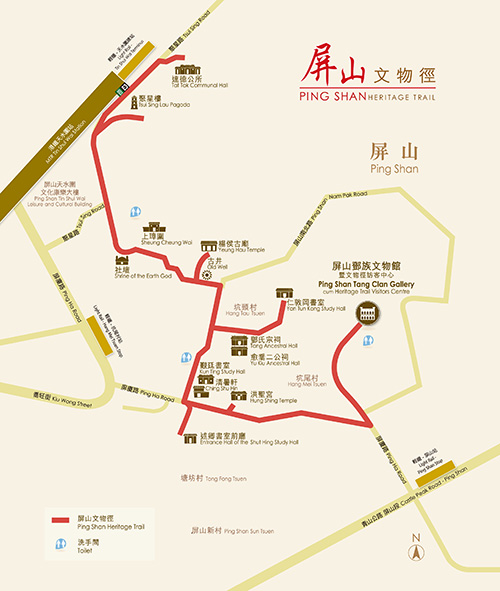
The first of its kind in Hong Kong, the Ping Shan Heritage Trail was inaugurated on 12 December 1993. Stretching about 1.6 km in length, the Trail meanders through Hang Mei Tsuen, Hang Tau Tsuen and Sheung Cheung Wai. It links up a number of traditional Chinese buildings within easy walking distance of each other to provide visitors with an opportunity to learn more about traditional life in the New Territories in a convenient half-day excursion.
The idea to set up a heritage trail was first mooted by the Antiquities Advisory Board, and then brought to fruition by the Antiquities and Monuments Office and the Architectural Services Department, with generous financial support of the Hong Kong Jockey Club and the Lord Wilson Heritage Trust. The Trail would not have been possible, however, without the support and co-operation of the Tang Clan in Ping Shan, which were a driving force behind the project.
Ping Shan in the Yuen Long district is one of Hong Kong’s most historically significant areas and the Tang Clan is one of the major clans in the New Territories who has a long and illustrious history. Tang Hon-fat, the 86th generation ancestor, moved from Jiangxi Province to Guangdong Province in the early period of the Northern Song dynasty (960-1127). He is regarded as the first generation Tang Clan ancestor of the lineage in Guangdong. During the middle period of the Northern Song dynasty, Tang Fu-hip, the great grandson of Tang Hon-fat, expanded his ancestors’ home in Shum Tin (present-day Kam Tin). The 7th generation ancestor, Tang Yuen-ching and his only son, Tang Chung-kwong, alias Man-lei, moved from Kam Tin to Ping Shan in the 12th century. Tang Yuen-ching is regarded as the first generation ancestor of the Ping Shan lineage.
After settling in Ping Shan, the Tang Clan established “Three Wais (walled villages) and Six Tsuens (villages)” – Sheung Cheung Wai, Kiu Tau Wai and Fui Sha Wai, and Hang Tau Tsuen, Hang Mei Tsuen, Tong Fong Tsuen, San Tsuen, San Hei Tsuen and Hung Uk Tsuen. They later built numerous traditional Chinese buildings such as ancestral halls, temples, study halls and pagoda for ancestral worship, clan gathering and education. The Ping Shan Tang Clan retains certain traditional customs to this day, such as the organisation of various ceremonies during festivals. They not only symbolise the folk culture of the Tang Clan, but also reflect the traditional and unique characteristics of life in the New Territories.
Click here to view the information of Ping Shan Heritage Trail in the Geographical Information System on Hong Kong Heritage
Please search the routes of different transportation modes for pre-trip planning.